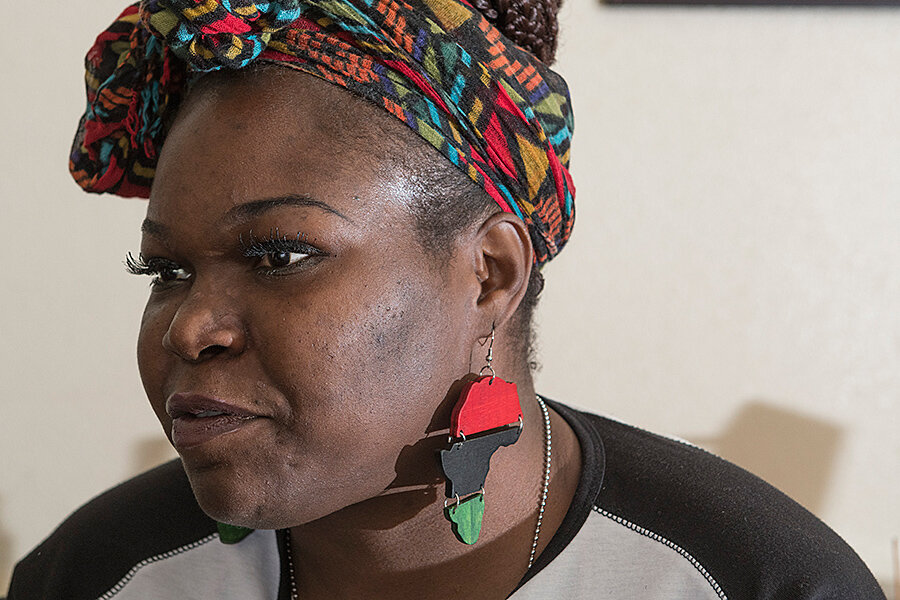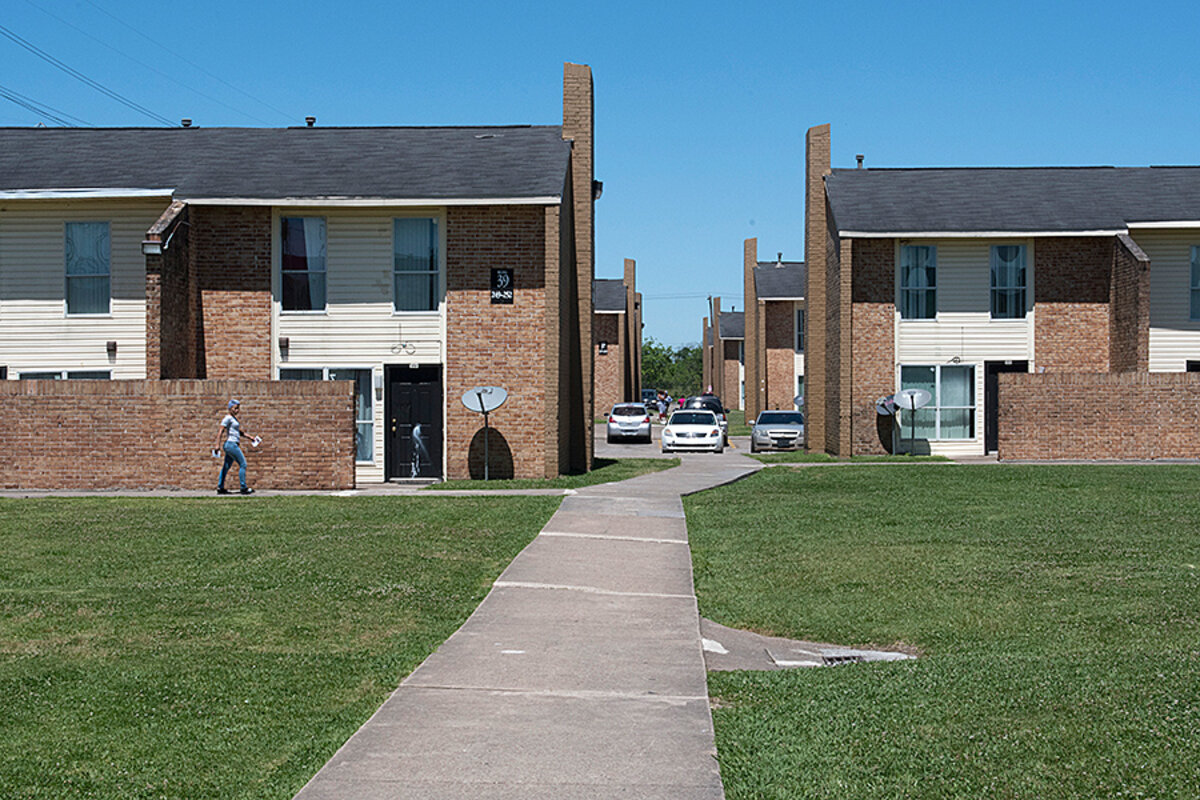Better housing as a path out of poverty: a tough test in Houston
Loading...
| HOUSTON
Iyoba Moshay had just started her shift when she got a text from Alvin, her 7th-grade son.
His school was on lockdown after a shooting, he said. There was a body prone on the street outside, visible from his classroom window.
Ms. Moshay gulped, and went back to her job tending bar downtown at the Houston Astros’ stadium. It was the second shooting that month near the school, which has an F grade from Texas regulators. For Moshay, a single mother, it was one more reason to wish she could move to a different part of town, far from the crime and poverty of her all-minority neighborhood.
“We want to live in a better community, and we want our children to feel safe,” she says.
For low-income families living in deprived parts of Houston and other cities, that’s easier said than done. Rentals cost more in better neighborhoods, and multi-family housing can be scarce. Even finding the money to move is tough.
But a body of research, notably by Stanford economics professor Raj Chetty and colleagues, has shown that poor families who move to wealthier districts see significant gains in their education, health, and income for their children. This upward mobility holds out particular promise for poor children who live in cities like Houston that are highly stratified by race and class.
Under President Barack Obama, federal housing policy sought to apply this lesson: Cities were coaxed to set goals for reducing racial segregation and to build low-income housing in integrated, low-poverty neighborhoods with better opportunities. This push coincided with a 2015 Supreme Court ruling that Dallas had violated the Fair Housing Act – the same civil-rights law that Mr. Obama was using – by concentrating subsidized housing in minority districts.
Last year, Houston stepped up to the plate: The city’s housing authority proposed a 233-unit apartment complex in which the majority of rentals would be subsidized. The $53 million project was to be built in a predominantly white neighborhood just over a mile from Houston’s fanciest mall, the Galleria.
Local opposition was swift, sustained – and effective. Thousands packed public hearings to berate officials for their choice of location and mobilized political allies in government. Last summer, the city pulled its support for the project.
In January, the Obama administration’s Department of Housing and Urban Development (HUD) said Houston had caved to “racially motivated opposition” in rejecting the Galleria-area project. It called on the city to remedy its housing policy or face referral to the Department of Justice’s enforcement division.
How Houston responds, and what stance HUD takes under the Trump administration, could shape the national debate over where to build low-income housing. The case also shows the strength of NIMBYism in stymying what advocates say is a cost-effective way to give poor children a shot at a better life at a time of rising concern over economic inequality.
HUD Secretary Ben Carson has offered little guidance on how he views affordable housing, though he previously criticized Obama for overreach in telling cities where to build. His department is one of many that Trump has targeted for cuts: HUD would see a 15 percent reduction under Trump’s proposed budget for fiscal year 2017.
Hard to find compromise
Dr. Carson will have discretion over how to handle the dispute with Houston, as would the Department of Justice in case of referral, says Michael Stegman, who served as senior housing adviser to the White House in 2015-16. But the rule issued by HUD in 2015 that requires cities to “affirmatively further” desegregation – and penalizes those that don’t – remains in effect and can’t be changed overnight by the new administration.
“Secretary Carson is going to have to oversee the implementation of the rule,” he says.
The dilemma for HUD, says Mr. Stegman, who is a fellow on housing policy at the Bipartisan Policy Center, is that the Obama-era rule is all stick and no carrot, since Obama couldn’t get extra funding from Congress to reward cities that pursued anti-discriminatory policies. This makes it harder to find compromise over fair housing provisions.
“We have these additional tools, but these are state and local practices, and litigation or taking back entitlements are very strong penalties. There’s nothing in between,” he says.
Houston Mayor Sylvester Turner, who is African-American, has rejected HUD’s complaint and said the city will continue to expand its affordable housing. He argues that the government must invest more in communities of color like the neighborhood where he grew up. “I still live in one of those communities. The answer is not to just move them over there. The answer is to invest in the communities where they are,” he said in a speech in January.
That message resonates with the Rev. Harvey Clemons Jr., a pastor who leads development projects in Houston’s Fifth Ward, a historically black neighborhood that is starting to gentrify. He faced resistance from HUD to financing 63 new housing units in his ward to replace a storm-damaged complex. Federal officials pressed the city to add housing in a higher opportunity area, in keeping with Obama’s policy, but eventually relented.
This is what the community needs, and shifting federal housing dollars elsewhere isn’t the answer, says Mr. Clemons. “You don’t run from a problem, you solve it.”
Jeffrey Lowe, an associate professor of urban planning and environmental policy at Texas Southern University in Houston, says it shouldn’t be an either/or choice. “We can do both,” he says, noting that cities like Boston have upgraded existing low-income housing while also financing new projects in higher opportunity areas.
“I’m hopeful that what the mayor desires and what HUD desires will begin a conversation around our values, and what Houston could do in terms of furthering fair housing opportunities,” he says.
History of segregation
Critics say that conversation has to start with the fact that Houston has a history of residential segregation, which its hands-off regulatory approach to housing has perpetuated. In its letter, HUD noted that since 2012 the city had directed 85 percent of tax credits for low-income housing to non-white neighborhoods. While some housing has been built in affluent suburbs, the main beneficiaries were the elderly, not black and Latino families with school-age kids.
Mr. Lowe says it’s impossible to remove race from the debate over where to build. “Most people in Houston when they think of public housing they think of black people. They certainly think of poor people. But I think the images that come to mind are black people,” he says.
The Galleria proposal was for mixed-income housing; only 10 percent of units were set aside for families with very low earnings. One-fifth would be rented at market rates. The majority would be for families who made between $25,000 and $41,500 a year, depending on household size.
“These people are the bank tellers and the wait staff that serve you. They’re good enough to serve you but not to live with you,” says Chrishelle Palay, Houston co-director for Texas Housers, a statewide advocacy group, referring to the opposition from Galleria residents.
Moshay, who earns up to $600 a week in salary and tips from her stadium job, fits this category. She’s lived in her current apartment for five years, using federally funded vouchers to help cover the $900 monthly rent. Most residents in her complex, a drab expanse of two-story buildings, are voucher recipients. When she’s home, she sits outside to keep a wary eye on her son.
“My idea of a community is that it’s somewhere where you feel comfortable with your kids living there,” she says. “I want him to have a normal life.”
In theory, Moshay could use her housing vouchers to move to a safer neighborhood. But she says it’s not worth trying because many landlords reject voucher recipients, which is legal in Texas but outlawed in other states. “People will just turn you down,” she says.








